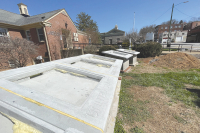Residents hear about alternatives for Southern Loop
By Jennifer Garlesky • Staff Writer
Tom Dowell searches a large topographic map of Jackson County for his home located along Airy Lane. He is one of the many residents whose homes may be in jeopardy if the North Carolina Department of Transportation gets its way and the Southern Loop is built.
The Southern Loop, a four-lane bypass that would run through Jackson County from U.S. 441 to U.S. 23-74 near Scotts Creek, will reduce traffic congestion along N.C. 107 out of Sylva, according to DOT officials.
“It could be affected,” Dowell said about his home of 32 years. He was one of more than 100 residents who attended a public hearing about the road on Jan. 10.
“I am opposed because if the problem is the traffic on N.C. 107, I don’t see how this will solve it,” Dowell said. “I see no reason why this will help.”
Because of such opposition, DOT has agreed to do a traffic study to examine alternatives to the Southern Loop. Members of Jackson County’s Smart Roads Alliance, however, want their own study done to make sure that all alternatives are equitably considered.
Related Items
An alternate route
“Finding an alternate is the best solution and best defense,” Smart Roads Chairwoman Jeanette Evans said at the Jan. 10 meeting. “It will help us generate ideas and focus on what we are up against. It’s going to take a community to find a solution to this.”
The main focus of the public meeting was to discuss alternatives to the Southern Loop.
Guest speaker Walter Kulash, a private traffic engineer who has been working with Smart Roads for four years, presented a potential alternative to the Southern Loop at the meeting.
Kulash says that instead of building a multi-lane freeway like the proposed Southern Loop, an alternative would be to build several smaller roads. He says that new roads and upgrades to existing roads like North River Road and King Creek Road will create a network that will be able to handle regional traffic better.
Implementing a plan like this, however, is “much more trickier to plan and in many ways more demanding,” said Kulash.
One part of Kulash’s presentation included a breakdown of the time it takes to get to different places along N.C. 107.
“Every trip is hostage to this highway,” he said.
Kulash said with the alternate solution in place you can get to places without starting at the primary highway.
Also at the meeting was Joel Setzer, N.C. Department of Transportation Region 14 division engineer. Setzer was invited by the Smart Roads group but was asked not to speak or answer questions at the meeting.
Seltzer, in an interview from his office, said that both parties — Smart Roads and DOT — agree more capacity is needed.
“This transportation problem is a real problem, and a do-nothing approach is something that is detrimental,” Setzer said.
A network of roads
By implementing a network of streets, community members will be able to walk to stores and access the downtown district by foot or bike. Imagine being able to walk to the Movie Gallery located along N.C. 107 by foot or bicycle instead of having to drive in the car.
Additionally, having numerous smaller streets will provide easier access for visitors and local drivers. When one looks at the proposed route of the Southern Loop on a map, Kulash says that it mainly benefits those entering the town from outside the area who want to access Western Carolina University or the retail stores.
“It’s good for the extra access, but how about those local folks,” he said.
Kulash’s presentation contained some information that Setzer said features similar concepts that the DOT is considering. Setzer references one of the connecting roads that Kulash showed during the presentation as a “feature that DOT is looking to explore in the bypass project.”
The connecting roadway that Setzer is referencing would connect U.S. 23-74 to old N.C. 107. According to Setzer “that connection is something that DOT is trying to do.”
“I don’t know if DOT is far off from what the Smart Roads is asking to be done,” he said in reference to Kulash’s alternative road proposal.
Under the network option, visitors and local drivers will be able to travel throughout the community without always using N.C. 107.
Both alternatives — the Southern Loop and a network of roads — will end up decreasing driving time, said Kulash. According to Kulash’s predictions, a driver spends about 17 minutes commuting along N.C. 107 right now, however, the travel time can be reduced to nine minutes if the Southern Loop is built. It will also be reduced to nine minutes if the roads are upgraded and the speed limits are increased to 45 mph, he said.
Another benefit of the network of roads is that it will cut down on the number of local trips.
According to Kulash, the DOT estimates that the number of cars using N.C. 107 will reach 56,000 per day in 2025; however, this number will be reduced if the network of roads is implemented.
By 2025 the traffic count on N.C. 107 will reduce to 25,000 vehicles if new smaller roads are built, which is the same number expected if the Southern Loop is built.
Kulash’s alternatives are not something that DOT is going to brush aside.
“We do plan to hopefully talk with Kulash on Thursday to compare notes,” Setzer said. “We plan to look at some of his concepts and look at what could be added as an alternative to this project.”
The Smart Roads meeting also brought out several Jackson County public officials. Some officials present at the meeting included Sylva Aldermen Maurice Moody, Ray Lewis and Sarah Graham, Sylva Town Manager Jay Denton, and Jackson County Commissioners Tom Massie and Mark Jones.









